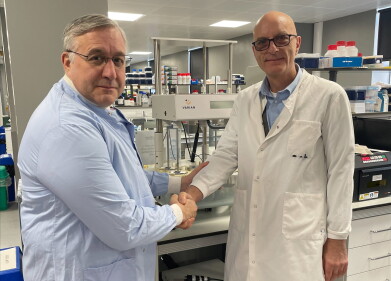News
Automated Screening helps to Fight Crop Disease
Mar 18 2021
A workflow system using liquid handling robots to identify the genetic basis to prevent plant pathogens has been created by researchers at the Earlham Institute. Through enhanced visual check of genetic mutations linked to the control of crop disease, analysis times have been greatly reduced, thus accelerating development of novel products for crop protection in the agricultural industry.
The Earlham Biofoundry, alongside the Truman Group at the John Innes Centre, used this automated workflow to experiment on the control of a common potato pathogen which causes a devastating disease known as ‘potato scab’.
Co-Corresponding author of the study and Earlham BIO Foundry Manager Dr Jose A. Carrasco Lopez, said: “We demonstrated the applicability of biofoundries to molecular microbiology by using automated workflows to identify the genetic basis of growth inhibition of the plant pathogen Streptomyces scabies by a Pseudomonas strain isolated from a potato field.
“The EI Biofoundry generated workflow resulted in the identification of a gene cluster linked to the inhibitory effect on the potato pathogen which made the process much easier. By identifying the new genetic determinants, it opens the door to finding the metabolites involved in pathogen inhibition.”
“Manual screenings are usually performed with pin replicators in the same plate, where many mutants are together in the presence of the pathogen. This means that a mutant in a non-related gene could mask the lack of inhibitory effect of a real-hit mutant by proximity.
“We solved this by creating individual assays for each mutant - this impacts the scientific community significantly and provides enhanced control of crop pathogens based on biological processes which will translate into better crop yields,” added Dr Carrasco Lopez.
Collaborator and first author Alaster Moffat, PhD student in the Truman Lab, who approached EI about the possibility of automating the biosynthetic screening, said: “We had previously been unable to identify genes important for inhibiting the growth of the pathogen using bioinformatics approaches, but this workflow allowed us to rapidly probe the effects of almost every accessory gene in the Pseudomonas isolate's genome directly, and find a novel biosynthetic gene cluster within a very short timeframe.”
The EI Biofoundry plans to progress the study by creating workflow modifications to adapt to new projects and pathogens. “Once we have identified the gene cluster involved in the synthesis of this new metabolite,” said Dr Carrasco Lopez, “scientists could mutate every single gene to identify functions and essential genes for metabolite synthesis. This can be applied to control plant pathogens and further improve the potato crop’s yield, to test the species’ inhibitory range of these metabolites and to identify new genes from other bacterial species linked to the impairment of other crop pathogens.”
‘A biofoundry workflow for the identification of genetic determinants of microbial growth inhibition’ is published in Synthetic Biology.
More information online
Digital Edition
ILM 50.2 March 2025
March 2025
Chromatography Articles - Effects of small deviations in flow rate on GPC/SEC results Mass Spectrometry & Spectroscopy Articles - Waiting for the present to catch up to the future: A bette...
View all digital editions
Events
Apr 09 2025 Tokyo, Japan
Apr 22 2025 Hammamet, Tunisia
Apr 22 2025 Kintex, South Korea
Analytica Anacon India & IndiaLabExpo
Apr 23 2025 Mumbai, India
Apr 23 2025 Moscow, Russia



















